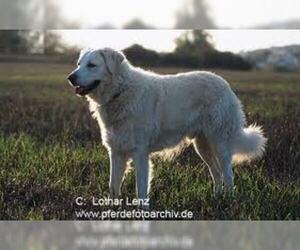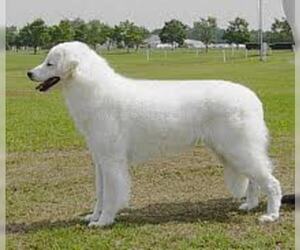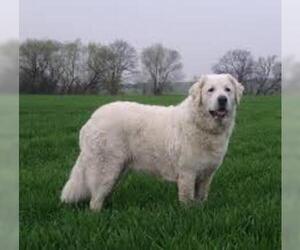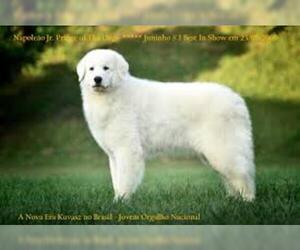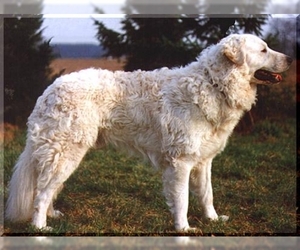
All about Kuvasz dog breed
A.K.A. :Hungarian Kuvasz, Kuvasz Dog, Hungarian Guardian Dog
Size
Grooming requirements
Exercise requirements
Good with other dogs
Watchdog ability
Energetic
Training requirements
Playful
Affectionate
Good with other pets
Good with children
Good with strangers
Winter
Summer
Healthiness
Protective
Life Span
| Pure Breeds | Member |
| Breeds A - Z | K |
| Breeds by Group | Flock Guards & Mastiffs Working |
| Breeds by Trait | Good With Kids High Stamina Dog Breeds Smartest Dog Breeds |
| Overview: | The majestic Kuvasz is an ancient Hungarian livestock guardian dog, renowned for its striking beauty and fiercely protective nature. Originating as early as the 13th century, this breed boasts a substantial size, typically weighing between 70-115 pounds, and is immediately recognizable by its stunning, dense white coat and powerful, athletic build. Temperamentally, the Kuvasz is intelligent, independent, and incredibly loyal to its family, but can be reserved or even suspicious of strangers, a trait stemming from its guardian instincts. While devoted, their independent streak means they require experienced owners who can provide consistent training and early socialization. Due to their size, activity level, and strong guarding instincts, they are generally not suitable for apartment living and thrive in homes with spacious, securely fenced yards. For families, they can be wonderful companions, especially with older children who understand boundaries, but their protective nature necessitates careful supervision around new visitors. Health-wise, the breed is generally robust, but like many large breeds, they can be prone to hip and elbow dysplasia, osteochondritis dissecans (OCD), and certain autoimmune conditions. Regular veterinary check-ups and a high-quality diet are crucial for maintaining their well-being. |
F.A.Q.
All You Need to Know About the Kuvasz BreedThe majestic Kuvasz, originating from Hungary, is a striking, large livestock guardian known for its beautiful white coat and dignified presence. Renowned for their loyalty and protective instincts, Kuvasz dogs are intelligent but possess an independent spirit, requiring experienced owners capable of consistent, positive reinforcement training. Physically, they are robust, with a dense double coat that needs regular brushing to manage shedding. While naturally calm indoors, their large size and moderate exercise needs (daily walks, secure yard playtime) make them unsuitable for apartment living. They are typically good with children in their own family but can be wary of strangers, necessitating early socialization. Common health considerations include hip and elbow dysplasia, so choosing a reputable breeder is crucial. Prospective owners should be prepared for a devoted, powerful companion who excels in a home with ample space and a clear leadership structure.
Kuvasz Weight: Adult Kuvasz typically weigh between 80 and 115 pounds. Males are generally heavier, averaging 100-115 pounds, while females are usually 80-100 pounds. This is the healthy weight for Kuvasz, indicating their average size as a large, powerful breed.
Kuvasz Height: How Tall is a Kuvasz?
When considering a Kuvasz, understanding their adult size is important! The average height of a Kuvasz is quite substantial, reflecting their majestic and powerful build. Measured at the shoulder (withers), adult Kuvasz typically stand between 28 to 30 inches (71 to 76 cm).While this provides a good average size, there can be some variation based on gender and individual genetics:- Males (Dogs): Generally, male Kuvasz are larger and tend to fall into the higher end of the range, often between 28 to 30 inches.
- Females (Bitches): Females are typically slightly smaller but still impressive, usually ranging from 26 to 28 inches (66 to 71 cm).
The Kuvasz colors are primarily white, the only AKC recognized Kuvasz color. This pure white coat, often described as a self-color, can range from a stark snow-white to an ivory or light cream shade, but pure white is the preferred and accepted standard. While some puppies might be born with a very pale cream or biscuit tint, these markings typically fade to white by adulthood. Any other exotic Kuvasz variations or rare coat types such as black, brown, fawn, brindle, blue, lilac, merle, or chocolate are not characteristic of the breed and would indicate a mixed lineage, as these are not natural Kuvasz colors. Therefore, when searching for a purebred Kuvasz, expect to find only the distinctive white coat. Prices for purebred Kuvasz will reflect this single color standard; any claims of "rare" colored Kuvasz often indicate a non-purebred animal.
The Kuvasz personality is defined by a strong sense of independence, loyalty, and protectiveness. Originally bred as livestock guardians, they possess an inherent need to observe and protect their family and home. They are intensely devoted to their loved ones, forming strong bonds and displaying unwavering loyalty. While not overly demonstrative, their affection is deep and steadfast.
Regarding friendliness, the Kuvasz is typically reserved with strangers, often appearing aloof or watchful. They are not naturally sociable with unknown individuals and may be suspicious until they deem a person trustworthy. Early and extensive socialization is crucial to help them develop appropriate responses to new people and situations.Their adaptability to apartment living is generally poor. Kuvasz need space to roam, patrol, and feel like they have a territory to guard. A secure, fenced yard is essential for their physical and mental well-being. They thrive in environments where they have a job to do, even if that job is simply overseeing their property.With children, a well-socialized and properly trained Kuvasz can be a gentle and patient companion, often adopting a protective role. However, due to their size and guardian instincts, supervision is always recommended, especially with very young children. They are generally tolerant of their "flock" (human family) but may not appreciate rough play from unfamiliar children.When it comes to other pets, the temperament of Kuvasz can be variable. They can coexist peacefully with other pets they've been raised with, especially if introduced early. However, their strong prey drive and dominant nature can make introductions to new, smaller pets challenging. They may view unfamiliar dogs as intruders on their territory. Careful, supervised introductions and ongoing training are necessary for a multi-pet household.In summary, the Kuvasz is a magnificent, intelligent breed best suited for experienced owners who understand their guardian instincts and can provide consistent training, ample space, and dedicated socialization. They are not for the faint of heart, but for the right owner, they offer unparalleled loyalty and a truly unique companionship.The Kuvasz temperament is characterized by a strong sense of loyalty, independence, and protectiveness, reflecting its heritage as a livestock guardian. They are not typically overtly friendly or sociable with strangers, often appearing reserved or aloof, but are deeply devoted to their families. This breed is generally not suited for apartment living due to its size, need for space, and guardian instincts which can lead to barking at perceived threats.
With children, a well-socialized Kuvasz can be gentle and patient, especially with those in their own family, but supervision is always recommended due to their size. They may view unfamiliar children as intruders. Regarding other pets, they can coexist peacefully, particularly if raised with them from a young age, but their natural guarding instincts may lead them to try to "manage" other animals. Known for their intelligence, Kuvasz can also exhibit a strong independent streak and a tendency toward stubbornness, making consistent, positive-reinforcement training essential. They are sensitive dogs and do not respond well to harsh correction; a firm yet gentle approach is best. Early socialization is crucial to foster a well-adjusted and confident Kuvasz personality, ensuring they become a reliable and cherished companion dog behavior.Kuvasz Care: Daily Maintenance and Health TipsCaring for a Kuvasz involves understanding their specific needs. Kuvasz care is generally straightforward for their size. Grooming requires daily brushing to prevent matting of their dense double coat and reduce shedding, especially during seasonal changes. While not a low-energy breed, exercise limitations are important: they need regular, moderate exercise, like daily walks or playtime in a secure yard, to stay healthy and prevent boredom. Avoid over-exercising young puppies to protect their developing joints.Dietary considerations for a Kuvasz involve high-quality dog food appropriate for large breeds, with controlled portions to maintain a healthy weight. They are not brachycephalic, so wrinkle and ear cleaning are not common concerns beyond routine ear checks for cleanliness and infection prevention. Climate sensitivity isn't a primary concern due to their protective coat, though they should always have access to shade and water in hot weather.Common health tips for Kuvasz include proactive dental care with regular brushing to prevent dental disease. Skin issues can sometimes occur, so monitoring for allergies or hot spots is essential. Weight management is crucial to prevent strain on their joints, especially as they age. Regular veterinary check-ups are vital for early detection and treatment of potential health concerns. Overall, how to care for a Kuvasz focuses on consistent grooming, appropriate exercise, a balanced diet, and preventative health measures.
Kuvasz Activity Level: While large, the Kuvasz generally has a moderate activity level, balancing short bursts of energy with long periods of rest. They are not typically a high-energy, constantly-on-the-go breed. Their exercise needs are manageable; they thrive on daily walks of at least 30-60 minutes, and benefit from access to a securely fenced yard where they can patrol and self-exercise. They enjoy interactive playtime, especially with their family, but are not necessarily looking for intense, all-day activities. They are known for their quiet observation and watchful nature, which often involves considerable downtime. Due to their size and historical role as livestock guardians, they appreciate having a "job," even if it's just overseeing their home and family. They are not brachycephalic, so they do not have the breathing limitations associated with flat-faced breeds, allowing them to tolerate exercise in various conditions, though common sense regarding extreme heat or cold should always be applied. The question "how active are Kuvasz" can be answered by stating they are suitable for families who enjoy regular, moderate outdoor activities rather than intense, high-impact sports. They are more suitable for active families willing to provide consistent daily exercise than for extremely low-energy households that cannot commit to their daily walking requirements.
Breed Breakdown: What Experts Say About the Kuvasz
I would rate the Kuvasz's "Size" trait as a 9.The Kuvasz is a very large breed. Males typically stand between 28-30 inches tall and weigh 100-115 pounds, while females are 26-28 inches and 70-90 pounds. Their impressive height, significant weight, and robust, powerful body structure put them at the upper end of the size spectrum for companion dogs. When compared to the vast majority of other breeds, the Kuvasz is clearly among the largest. Due to their substantial size and need for space, they are not at all suited for apartment living or households with space constraints. Travel can also be challenging given their need for a large vehicle and their preference for familiar environments. They are best suited for homes with ample outdoor space where they can move freely and have a clear "territory" to oversee.
The Kuvasz breed rates a 6.5 out of 10 for grooming requirements, placing them in the moderately high-maintenance category. While they don't have the extreme needs of a poodle or a dog with extensive skin folds, their thick double coat is a significant factor. They are substantial shedder, especially during seasonal changes, requiring frequent brushing (2-3 times a week, daily during shedding season) to prevent matting and manage loose hair. Their dense coat can also trap dirt and debris, necessitating regular bathing to keep it clean and healthy. Although they aren't particularly prone to excessive skin folds, their floppy ears do require routine cleaning to prevent infections. Nail trimming is essential, as with all dogs, and their size means it's a more involved task if not started early. While not inherently prone to a wide array of skin issues, their thick coat can hide problems if not regularly inspected. Compared to other companion dogs, the Kuvasz requires consistent and somewhat specialized grooming due to their coat density and shedding volume, making them more demanding than a short-haired or less profusely coated breed.
I would rate the Kuvasz's exercise requirements as a 7 out of 10.While not hyperactive, the Kuvasz is a large, powerful working breed with a history of guarding livestock over vast territories. They possess a significant amount of stamina and require more than just a quick stroll around the block. Their energy levels are moderate to high, and they thrive on regular, sustained movement. They are not brachycephalic, so respiratory limitations are not a concern. To stay healthy and mentally stimulated, a Kuvasz needs at least an hour to an hour and a half of dedicated exercise daily, ideally broken into two sessions. This could include long, brisk walks, hiking, supervised off-leash playtime in a securely fenced area, or even trotting alongside a bicycle once mature. They enjoy purposeful activities and can excel in canine sports like obedience or even scent work, which provides mental as well as physical exertion. Without adequate exercise, a Kuvasz can become bored, destructive, and potentially develop behavioral issues, as their strong protective instincts can be misdirected without an outlet. They are not a breed that thrives with minimal activity; structured routines and opportunities for ample physical and mental engagement are essential for their well-being.
I would rate the Kuvasz's "Watchdog Ability" as an 8 out of 10. The Kuvasz is a breed with strong guarding instincts, historically bred to protect livestock from predators. This translates well into a household watchdog role. They are highly alert and possess excellent hearing, readily picking up on unusual sounds or movements. Their barking behavior is purposeful – they typically won't bark indiscriminately, but will use their deep, resonant bark to announce and challenge anything they perceive as a threat to their territory or family. Their territorial instincts are very pronounced, and they will establish a clear boundary around their home. When faced with unfamiliar people or sounds, they will investigate with a watchful intensity. While they are not inherently aggressive, their size, imposing presence, and willingness to stand their ground make them a significant deterrent to potential intruders. They are certainly not passive companions in this regard; they are very capable of providing meaningful early warnings and will actively work to deter perceived threats in a home environment.
I would rate the Kuvasz's "Good with Other Dogs" trait as a 4 out of 10.While not inherently aggressive, the Kuvasz is a livestock guardian breed with a strong independent nature and a natural inclination to be protective and dominant, especially with unfamiliar dogs. They are not typically a breed that thrives in the company of many other dogs, particularly those of similar size and sex. Introductions to other dogs need to be carefully managed and supervised from a young age, with extensive socialization being paramount. They can be particularly wary of strange dogs entering their perceived territory and may challenge them. While they can coexist peacefully in multi-dog households if raised with them and established in a clear hierarchy, they are generally not known for their playful sociability with all canines. Their patience for high-energy or overly boisterous dogs, especially those that don't respect their space, can be limited. Their protective instincts can also be misconstrued as aggression towards other dogs, particularly if they perceive a threat to their human family or property. Coexistence requires careful training, strong leadership from the owner, and respect for the Kuvasz's natural tendencies.
I would rate the Kuvasz's "Energetic" trait as a 4.While the Kuvasz is a working breed with a history of guarding livestock, their energy isn't typically expressed as frantic, high-intensity bursts like a Border Collie or a Jack Russell Terrier. They possess a deep, sustained endurance for their historical role, which involved patrolling and being alert over long periods rather than sprinting or performing agile maneuvers. They are naturally active and require consistent exercise to remain healthy and well-behaved, but they are also known for their ability to be quite laid-back indoors once their needs are met. Their playfulness often involves more deliberate, sturdy play rather than constant motion. They have a moderate need for physical stimulation, benefiting from long walks, supervised outdoor time in a secure yard, or engaging in scent work or other mental challenges. They can certainly participate in outdoor activities and have good stamina for their size, but they aren't built for high-speed or highly agile athletic endeavors.It's important to note that the Kuvasz is *not* a brachycephalic breed. They have a long, well-defined muzzle, which means their respiratory system is not inherently compromised by anatomical features that restrict airflow. Therefore, their stamina and exercise tolerance are not negatively affected by a brachycephalic anatomy; rather, they possess excellent respiratory capacity for their size and activity level. Their energy is more about sustained presence and watchfulness than explosive bursts.
I'd rate the Kuvasz's "Training Requirements" a 9 out of 10.While intelligent, the Kuvasz possesses a profound independent streak and a stubborn nature typical of livestock guardian breeds. Their attention span can be short for repetitive, non-instinctual tasks, and their responsiveness to commands is often weighed against their own assessment of the situation rather than immediate compliance. This breed absolutely demands unwavering consistency and a firm, confident, yet gentle handler. Positive reinforcement is effective, but it needs to be paired with clear boundaries and an understanding that you are guiding, not forcing, a thoughtful and self-reliant dog. They are decidedly *not* beginner-friendly and require experienced handling and highly structured routines from a very young age to channel their strong protective instincts and independence constructively. Owners must be prepared for a long-term commitment to training and socialization to ensure a well-adjusted and manageable companion.
I would rate the Kuvasz's "Playful" trait around a 4 out of 10.While not entirely devoid of playfulness, the Kuvasz is a majestic and serious breed with a strong independent streak, rather than an effusive, constantly fun-loving companion. Their typical activity level is moderate; they appreciate a good long walk or the opportunity to patrol their territory, but aren't generally bouncing off the walls. Love for games and interaction tends to be on their own terms – they might engage in a brief play session, especially when younger, but it's not usually a sustained or frantic activity. They are not typically attention-seeking in a boisterous way; their affection is often shown through quiet presence and watchful guarding. Response to toys and playtime is generally subdued compared to many companion breeds; they might bat a toy around for a bit but aren't usually obsessed with fetch or tug-of-war. Overall enthusiasm in daily life is more about dignified observation and fulfilling their protective instincts rather than exuberant joy. Compared to other companion dogs, the Kuvasz is significantly more laid-back and reserved, valuing calm and purposeful activity over constant spirited antics.
I would rate the Kuvasz's "Affectionate" trait at a 6.While immensely loyal and sensitive to their owner's emotions, Kuvasz are not typically overtly demonstrative or physically clingy dogs. They form deep bonds with their families and will often follow them around the house, maintaining a watchful presence. Their loyalty is unwavering, and they are acutely aware of their owner's moods. However, they aren't generally "lap dogs" or prone to constant cuddling. They appreciate affection on their own terms, often through a gentle lean or a close presence rather than intense physical contact. They thrive on the security and companionship of their human family but maintain a degree of independence characteristic of their guardian breed heritage, often preferring to be near you rather than on top of you. They are more independent compared to breeds specifically bred for constant companionship and physical affection, valuing their role as protector and companion through their watchful presence and unwavering devotion.
I would rate the Kuvasz's "Good with Other Pets" trait a 4 out of 10.While not inherently aggressive, the Kuvasz's strong guarding instincts and high prey drive often make them a challenging breed to integrate into a multi-pet household without extensive socialization and ongoing management. They are naturally independent and their primary focus is protecting their flock (which, in a home, extends to their human family and territory), not necessarily befriending other animals. Their prey drive can be significant, making cats and smaller animals particularly at risk. Furthermore, their resource guarding tendencies can emerge with other dogs, especially regarding food, toys, or even their perceived "people." While they can, with diligent and early socialization, learn to tolerate other pets, it rarely comes naturally. They will almost always require significant training, supervision, and a clear understanding of hierarchy to coexist peacefully, and even then, their inherent traits mean a certain level of vigilance will always be necessary. They are not a breed that is naturally sociable or immediately accepting of other animals; instead, they require a dedicated owner to manage their instincts for harmonious multi-pet living.
The Kuvasz breed rates a 4 out of 10 for "Good with Children."While inherently protective of its "flock," including its human family, the Kuvasz is not a breed naturally suited for all families with young children. Their primary purpose as livestock guardians has instilled in them a very independent, serious, and sometimes dominant temperament. They are not known for being overly playful or tolerant of boisterous behavior and can be highly sensitive to noise and sudden movements. This protective instinct, while valuable for a flock, can manifest as guarding behavior even towards children they perceive as being roughhoused, or they may become possessive of toys and spaces. They are not inherently gentle or affectionate in the way many traditional family breeds are, and their patience for typical child-like antics is limited. Extensive socialization from a very young age, consistent and firm training, and constant supervision are absolutely crucial to ensure a Kuvasz can safely coexist with children, especially young ones. Even with all these measures, their large size and strong guarding instincts mean they are often better suited to families with older, more respectful children who understand how to interact appropriately with a guardian breed. They are not a breed that thrives on being handled roughly or subjected to the unpredictable nature of young children, and their patience can quickly wear thin, leading to potential snapping or nipping.
The Kuvasz breed rates a 3 out of 10 for "Good with Strangers." This breed is inherently a guardian and deeply devoted to its family, making them naturally reserved, watchful, and often aloof with unfamiliar individuals. While not typically aggressive without provocation, their primary instinct is to protect, and they view strangers with suspicion rather than immediate friendliness. They are prone to barking and can exhibit strong guarding behaviors in the presence of perceived threats or unknown persons entering their territory, including guests. While early and extensive socialization can help them tolerate or politely ignore strangers, they will rarely be truly outgoing or highly welcoming. They require consistent training from a young age to be reliably calm and accepting in public or guest-filled environments, as their natural inclination is to be wary and protective. They are not a breed that is naturally outgoing or effortlessly comfortable with strangers; rather, they must be taught appropriate conduct in these situations.
The Kuvasz breed rates a 9 out of 10 for winter tolerance.This breed possesses an exceptional double coat, consisting of a dense, soft undercoat and a coarse, medium-length outer coat. This combination provides excellent insulation against cold temperatures, snow, and ice. Their large size and substantial body fat further contribute to their ability to maintain body heat. Unlike brachycephalic breeds, the Kuvasz has a long snout, which aids in warming incoming air before it reaches their lungs, reducing the risk of respiratory issues in cold weather. Their historical role as livestock guardians in often harsh Hungarian climates has naturally selected for strong cold-weather resilience, making them well-suited for extended outdoor activity in cold climates without significant risk of hypothermia under normal winter conditions.Compared to many other companion dogs, the Kuvasz generally requires less special care during winter months. While no dog should be left indefinitely in sub-zero temperatures without shelter, a healthy Kuvasz is perfectly capable of enjoying and thriving with regular outdoor activity in cold weather that would send many other breeds shivering indoors. They benefit from consistent exercise regardless of the season, and winter provides a stimulating environment for them. Owners should still provide adequate shelter, fresh water (checking for freezing), and ensure their diet supports their activity level, but these are general good practices for any outdoor dog rather than special considerations for cold sensitivity in the Kuvasz.
The Kuvasz breed rates a 3 for "Summer" tolerance.While not brachycephalic, the Kuvasz is a large, thick-coated, double-coated breed originating from a colder climate. They are naturally built to withstand cold rather than heat. Their dense undercoat, which acts as insulation, becomes a liability in warm weather, trapping heat and making it very difficult for them to regulate their body temperature effectively. This puts them at a high risk for heatstroke, even during moderate summer temperatures. Outdoor activity must be severely limited to early mornings or late evenings on cooler days, and they absolutely require access to air conditioning or other climate-controlled environments during hot weather. They are significantly more sensitive to heat than many other companion dogs and require substantial special care in summer months to prevent serious health issues.
I would rate the Kuvasz breed's "Healthiness" trait as a 7.The Kuvasz is generally considered a robust and healthy breed, particularly when compared to many other large and giant breeds. They typically have a good life expectancy of 10-12 years, which is respectable for their size. Responsible breeding plays a significant role in maintaining their health, and dedicated breeders screen for common issues to minimize their occurrence.However, like most large breeds, they are predisposed to certain orthopedic problems such as hip and elbow dysplasia. Bloat (gastric torsion) is another serious concern that owners must be aware of and take preventative measures against. Less commonly, but still present, are issues like osteochondritis dissecans (OCD) and certain eye conditions. While these are not as prevalent as in some other breeds, they are still considerations that prevent a perfect score. They are not generally considered high-maintenance in terms of health, but preventative care, including proper nutrition to prevent rapid growth in puppies, regular exercise to maintain joint health, and awareness of bloat symptoms, is crucial for their well-being. They are more generally robust than many high-maintenance companion dogs, but not entirely free from health concerns typical of their size.
I would rate the Kuvasz's "Protective" trait at a strong 9 out of 10.The Kuvasz breed is exceptionally protective, exhibiting a natural vigilance and strong territorial instincts. They are highly alert, quick to notice anything out of the ordinary, and will readily sound the alarm with a deep, authoritative bark. Their loyalty to their owners is unwavering, and they possess a profound sense of responsibility for their family and property. While naturally reserved with strangers, they are not typically aggressive without cause, but their sheer size and imposing presence are often enough to deter intruders. If a threat is perceived, they are capable of taking decisive action to defend their loved ones and territory. The Kuvasz is not merely a companion dog; they are very much a working guard dog at heart, perfectly capable of offering meaningful and formidable protection in a household setting, a role they have historically fulfilled for centuries. Their protective nature is deeply ingrained and a defining characteristic of the breed.
I would rate the Kuvasz's "Life Span" trait as a 7 out of 10.Kuvasz dogs are generally considered to be an average to slightly above-average long-lived breed compared to many other large companion dogs. Their average life expectancy typically ranges from 10 to 12 years, with some individuals living longer. While they are prone to certain health issues common in large breeds, such as hip and elbow dysplasia, patellar luxation, and certain eye conditions, responsible breeding practices and diligent veterinary care can significantly mitigate the impact of these genetic predispositions. Cancer and bloat can also be concerns, but are not exceptionally prevalent compared to some other very large breeds. Overall, with good nutrition, exercise, and preventative healthcare, a Kuvasz can enjoy a respectable and fulfilling lifespan.
Kuvasz Dogs for adoptionSee all dogs for adoption
Similar Dog Breeds for Kuvasz
Quick Breed Selector 0 - not important, 1 - smallest, 10 - largest
Variants & Mistakes :Kuvas, Kuvaz, Kuvass, Quvasz, Kouvasz, Kuvacz, Cuvasz, Kuwasz, Kovasz, Kuwas, Kouvas, Quvas, Kovas, Kuwaz, Quvaz, Kuvazs, Kuvassz, Kuvazzz, Kuvvasz, Kvsz, Kvs, Kvasz, Kiuvasz, Quvass, Kovass, Kuvazz, Quvazz
